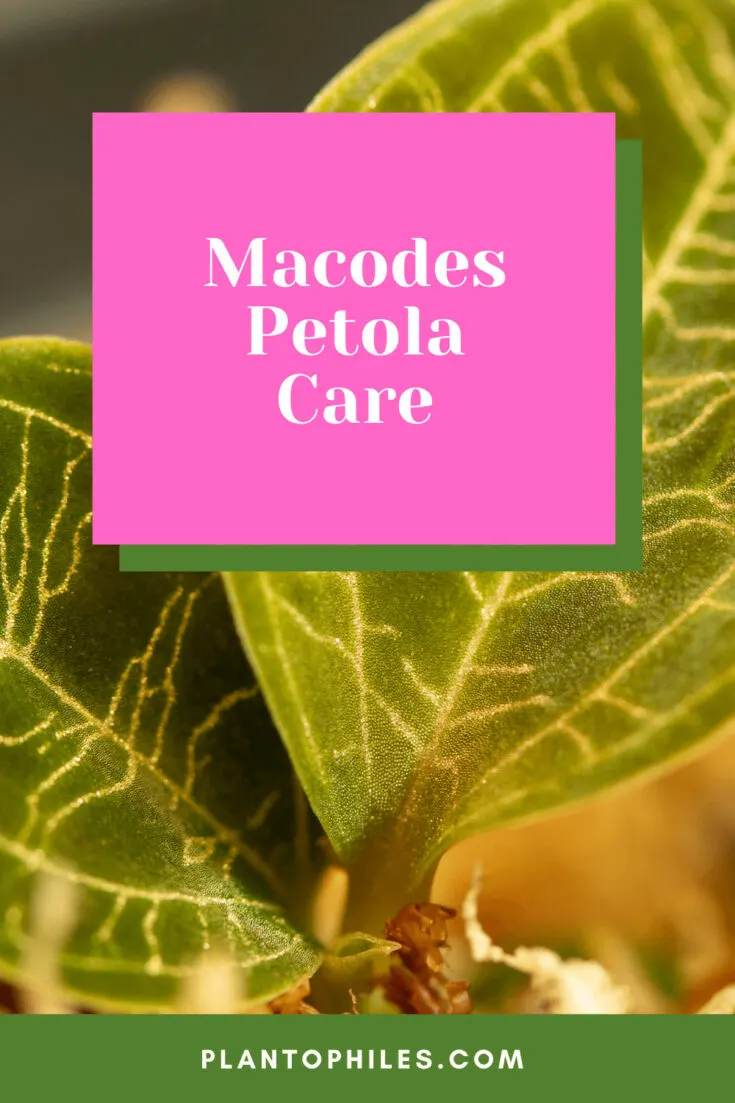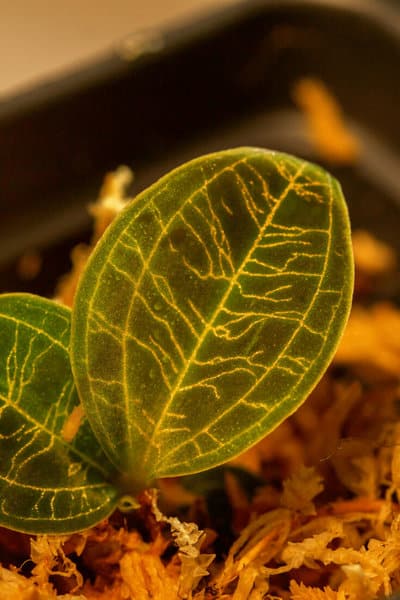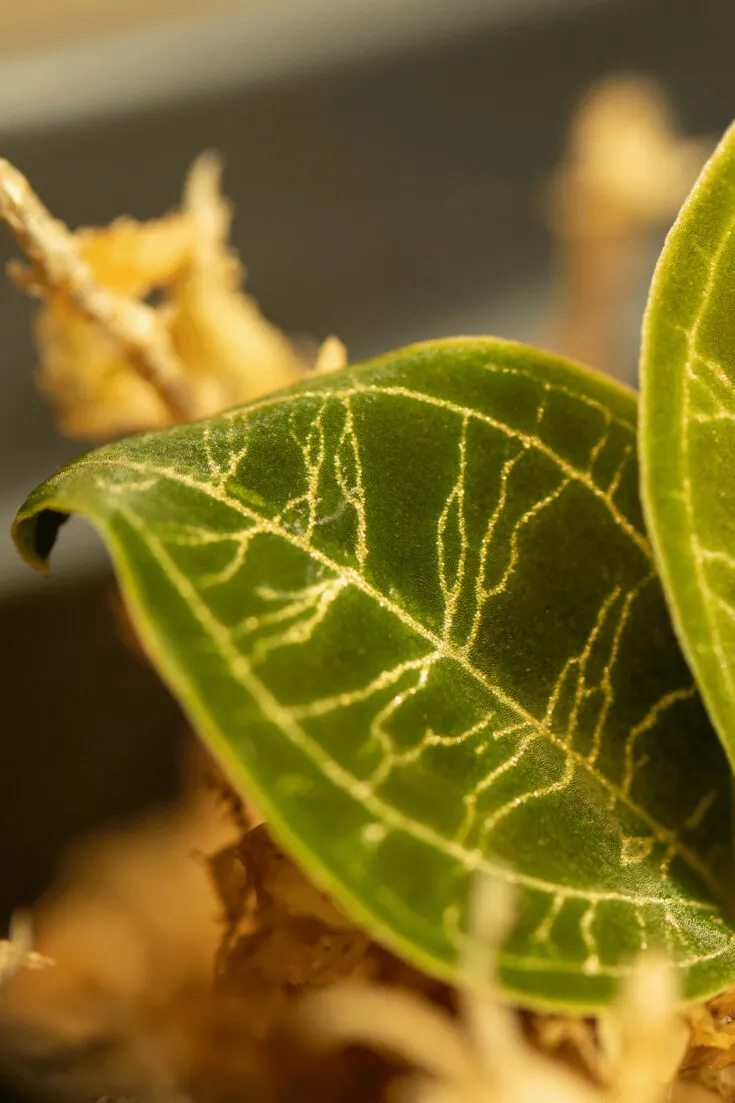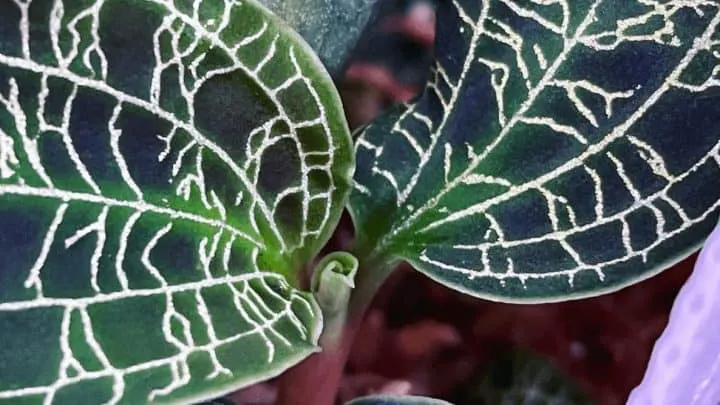(image credits, IG: philodendreams)
I was first introduced to Macodes petola by my nursery guy who told me to “be brave” and purchase a specimen!
I was under the impression that Macodes petola care was very complicated and there wasn’t that much information amongst my (indoor)-gardening friends on jewel orchids in general.
However, I was blown away by the small elliptical velvety leaves with the crystalline sparkly veins that came alive in the light as if electrocuted; they had an otherworldly feel like they belonged to planet Pandora!
Macodes Petola Care
For Macodes Petola care keep temperatures around 80-85ºF (27-29 °C) during the day and 65-67ºF (18-19 °C) during the night. You can grow this Jewel Orchid in loose soil, pure sphagnum moss, or mixes using perlite, peat. It is a shade-loving plant that thrives in filtered light. They need moist soil and regular watering. These plants love high humidity above 85%. Use a balanced or nitrogen-rich fertilizer at 1/4-1/8 strength weekly.

Macodes Petola Care
Table of Contents
Macodes Petola Care Guide
Orchid enthusiasts grow Macodes petola for the foliage rather than the tiny tan flowers on erect stalks which are quite nondescript. In fact many even prune off the buds.
Anyway, I finally bought my specimen that day and I have never regretted it. It’s pure joy watching every new leaf emerge in loose whorls.
If you follow some basic Macodes petola care guidelines it’s a very rewarding jewel orchid to have in your collection.
Soil
Macodes petola needs well-draining porous potting soil.
Macodes petola is native to Java, Malaysia, Sumatra, Borneo, Philippines, and the southern islands of Ryukyu.
It grows terrestrially one loose forest soil and along river banks (unlike most other orchids which are epiphytic). That is why in my experience you can grow Macodes petola quite easily even in regular soil.
There are several opinions flying around on the internet about sphagnum moss, perlite, peat, etc.
They’re great to create a substrate that is very porous and well-draining as well as moisture-retentive – exactly what jewel orchids like.
That said, even simple everyday soil, crushed leaf litter, bark, and gravel are great for Macodes petola too. In fact, it’s what they grow on in the wild.
You need to grow Macodes petola in a well-draining soil mix dense in organic nutrients and very porous so that the excess water must drains swiftly and thoroughly.
Another Macodes petola care hack is to add crushed eggshells or oyster shells to the soil substrate because in nature they are often found in limestone regions.
LIGHT
Bright, indirect light is perfect for Macodes petola care. This is positioned as a shade-loving plant and I’d agree with that.
But a little bright filtered light brings out the colors in the leaves much better in my experience. Also, very low light makes the rhizomes leggy.
Direct sunlight is a clear no-no. Leaves will fade and scorch in direct sunlight.
Overall, Macodes petola care needs are better managed if it is grown indoors under adjustable growlights where the light condition can be set to mimic the forest conditions of consistent and prolonged bright shade.
If you don’t have grow lights then a couple of feet away from a sunny east window would be great too.
WATERING
Macodes petola needs to be watered regularly as it prefers the soil to be slightly moist.
This is the most critical aspect of Macodes petola care. It’s a thirsty plant, but it doesn’t appreciate waterlogging.
In its native habitats in Java, Malaysia, Sumatra, Borneo, Philippines, and the southern islands of Ryukyu this jewel orchid grows on river beds or in swampy forests, where the dry season is not very long.
Rainfall is intense throughout the year. The key is to never let the soil mix go bone dry.
Likewise, when you grow Macodes petola at home your plant needs to be regularly watered. It is essential to keep the soil consistently moist.
That’s the reason why all the soilless substrate fans using sphagnum moss and peat are successful with jewel orchids because these substances really hold moisture well.
But remember, the soil can’t be soggy wet like a paddy field. The water needs to completely drain out.
During the summer months I grow Macodes petola with an alternate day watering cycle and gradually cut back as winter approaches. In winters I moisten the soil with warm water.
TEMPERATURE
For ideal Macodes petola care the average day temperature has to be 80-85ºF (27-29 °C), and the average night temperature is 65-67ºF (18-19 °C).
So basically, it needs summer through the year!
This unique orchid is indigenous to warm and muggy rainforests in Southeast Asia. It lives in forest shade at lower altitudes where organic life makes the air warm.
You’ll need to replicate that throughout the year to grow Macodes petola.
The northern winters are tough times for this fleshy and frost-shy plant. I’d strongly advise that you bring it indoors as soon as autumn arrives.
Once indoors keep it away from cold drafts or hot radiator air. The lesser the temperature fluctuation the better for the plant.

The ideal temperature for Macodes petola is 80-85ºF (27-29 °C) during the day
HUMIDITY
In the rainforests, the air is muggy with humidity levels >85%. If you grow Macodes petola in such conditions they’ll love it and reward you with great growth.
But what I can say about Macodes petola care is that keeping the growing medium and roots moist is much more important than maintaining high humidity.
I’ve grown it successfully in air-conditioned rooms and I’ve made sure that the roots are never dry. They have a strong preference for humidity but they’ll manage without, as long as the roots can feel moisture.
This is the sort of plant that I’d confidently place in a pebble tray. One smart Macodes petola care hack is to grow it in your bathroom. It will love the warm humidity there.
Warning: Never huddle the plant with other plants just to create humidity. Good ventilation should be ensured all the time as this plant is susceptible to moisture driven diseases.
I have a few terrarium enthusiast friends who vouch for Macodes petola as a fav of theirs. This method to grow Macodes petola is also an effective humidity management tool if you know how to manage fungal infections in terrariums.

Macodes petola is best grown in a terrarium as it needs high humidity levels
FERTILIZER
Either a balanced or nitrogen-rich fertilizer diluted to 1/4-1/8 of its prescribed strength applied weekly well to grow Macodes petola.
If jewel orchids are thirsty, they’re hungry as well! Macodes petola care requires regular feeding or they tend to look unhappy.
I’d recommend using an organic liquid fertilizer of very good quality. The other option is to use an orchid fertilizer.
A weekly application of a highly diluted solution is recommended. You need to dilute the solution to 1/4-1/8 of its prescribed strength or the plant will die due to salt buildup.
In addition to this make sure there’s plenty of organic fertilizer in the substrate to serve as slow-release feed. You can replenish this about twice a year.
PROPAGATION
Macodes petola can be propagated from offsets, stem cuttings, rhizome division, or air layering.
The propagation methods for Macodes petola are quite different from the typical flowering orchids.
They take root quite easily using traditional ways. It can be propagated from offsets, stem cuttings, rhizome division, or air layering.
But propagating Macodes petola takes time and patience. Also, like all orchids sterilizing garden tools is a must before cutting to prevent infection pathogens.
GROWTH
Macodes petola is a creeping rhizome that sprawls over the surface. They are smallish plants with a slow and timid growth habit so they won’t take over space very quickly.
The stem tips are erect although as they gain length they hug the ground. They do well in wide ceramic pots or terracotta pots. In about a year they grow to about 6 inches wide and 3 inches tall.
POTTING
As long as Macodes petola care requirements are satisfied they thrive even if they’re root-bound. They’d need to be repotted once a year particularly if you’re using sphagnum moss in your potting.
Moss tends to deteriorate causing fungal infections so it’s a good idea to replace the substrate annually.
The stems are delicate and tend to break while repotting. Therefore, I recommend that you line the base of the pot with plenty of gravel. This allows the plant to fall out easily.
MACODES PETOLA PROPAGATION STEP-BY-STEP GUIDE
Propagate Macodes petola through stem cuttings:
- Wait until June, just ahead of the growing season in the tropics. Use a healthy herbaceous tip cutting from a bug-free mother plant.
- It must have about 3 leaf nodes. Pluck off the leaves from the lower node.
- You can use rooting hormone powder but it normally sprouts even without.
- Pop it in evenly moist sphagnum moss and never let it dry out.
- Keep the cutting in bright shade or under grow lights maintaining a temperature of 27-29 °C (80-85ºF).
- This plant needs humidity. You can cover the cutting with a big transparent ziplock bag with a few holes.
- Don’t disturb the cutting until established.
Propagate Macodes petola through water rooting:
This method has proved to be quite successful for Macodes petola given its fleshy rhizomes.
- Take healthy stem tips with about 3-4 leaves i.e. a couple of nodes.
- Take a glass jar that’s 3/4th as tall as the cutting – a shot glass works.
- Fill it up with dechlorinated water or RO water and add half a drop of a good liquid rooting concentrate.
- Place your cuttings in this jar and keep it in a place where the temperature is maintained between 27-29 °C (80-85ºF)
- Change the water every week.
- It takes anywhere between 4 to 8 weeks for the roots sprouting out of the nodes.
- Once the roots are about a centimeter long and strong transfer them into potting soil.
A smart Macodes petola care hack is to keep propagating your plant and producing several baby plants as and when possible. Not every attempt will be to be successful. But this is your best hedge against winter losses.
Sieh dir diesen Beitrag auf Instagram an
COMMON PROBLEMS WITH MACODES PETOLA
The main problems when you grow Macodes petola are root rot and bacterial and fungal foliage disease and not so much about pests. Once stressed, they are slow to recover due to its slow growth rate.
Plant goes limp: The most likely cause of this is root rot. The soil has to necessarily be well-draining otherwise you’ll likely end up with root rot.
Pull the plant out of the pot immediately and wash off all the soil away from the roots. Healthy roots have to be cream/green and plump. If you find brown squishy ones you can be sure it’s rot.
Cut out all the affected parts with sterile tools and salvage healthy parts for propagation. Throw away the old substrate because you don’t want the disease to spread to other plants.
The other reason is the opposite of the first one which is that the roots died completely due to the lack of water.
Water-soaked blister on the leaf: This is a bacterial leaf spot. Typically these spots would have a yellow/green halo around the spot(s). First of all, isolate the plant and cut off the diseased leaf or leaves.
As a preventive stop getting the leaves wet while watering and keep the plant in a well-ventilated place. You can use a store-purchased bactericide on the affected plant as well as the plants that were nearby.
As with many orchids, some people report that the jewel orchid does better when it gets some airflow as it can help to evaporate water from the leaves. So, if you find that the foliage is looking a bit damp and limp, try airing out your terrarium a little.
Flagging & crispy leaves: This could occur if you’ve been underwatering the plant.
But if the soil moisture has been good in general and you’re still getting crisp edges it could be because you haven’t repotted in a while and the nutrients around the roots have dried out.
Repot in a loose-packed mix with plenty of slow-release organic material and then fertilize the plant regularly.
Scorched leaves: Macodes Petola can be sunburned when exposed to intense sunlight. Low-light orchids are especially susceptible to sunburn.
White dusty webby coverings along leaves and stems: This is due to spider mites which thrive in dryness. One preventive measure is to keep up the humidity around the plant. Keep an eye out for sapsuckers like aphids & mealybugs as well.
Wash down all the leaves and stems weekly to prevent this from happening. Do this in the morning and leave the plant in a well-ventilated spot to dry out during the day.
I would recommend regular application of horticultural oil or neem sprays as part of the Macodes petola care routine just as a preventive.
TIPS TO KEEP MACODES PETOLA PROBLEM-FREE
- Macodes petola needs more warmth and humidity compared to other orchids
- Keep the substrate evenly moist at all times
- The mix should be clunky and organic along with plenty of draining material like gravel, perlite but avoid sand.
- Feed the plant additional fertilizers regularly because this plant requires it.
- This plant has zero draft tolerance and stresses under direct sun.
- The roots of Macodes petola like it root-bound.
- A shower once a week helps the plant stay bug-free.
- Let the leaves dry out the leaves after watering.
- Always keep the plant in a well-ventilated spot.
- In winters manage the humidity using humidifiers and cut down watering and feeding but don’t stop completely.
FREQUENTLY ASKED QUESTIONS ABOUT MACODES PETOLA
What does Macodes petola root rot look like?
Root rot makes roots appear brown and mushy, and because nutrients are delivered to the plant via its root system, having no roots is almost certainly a death sentence for a plant. When inspecting your orchid’s roots, remember healthy orchid roots should be plump, green, and firm.
How to grow Macodes petola to look bushy?
This plant has a natural tendency for compact growth. They get lanky only in severe shade and poor soil nutrients. If you feed regularly and also provide it with adequate light you’ll likely grow Macodes petola into a nice compact mass. Occasional pruning helps.
Can you grow Macodes petola under artificial light?
Yes, you can grow Macodes petola successfully under fluorescent light kept on for about 12 hours a day. Set it to a bright shade light level.
Is Macodes petola toxic to pets?
Macodes petola is non-toxic to humans and animals.
Should I mist my Macodes petola?
Normally I wouldn’t recommend misting for jewel orchids for they are susceptible to bacterial leaf spots. However, misting with rainwater is an effective form of foliar feeding recommended in Macodes petola care. Make sure you mist only in the mornings so that leaves have time to dry out completely.
CONCLUSION
Macodes petola is currently considered vulnerable (CITES status II) with restricted trade due to the risk of over-collection and use as a stimulant in Borneo traditional herbal medicine. But the tissue culture plantlets are easier to obtain these days.
It isn’t exactly a neglect proof plant. So if you’re new to the world of gardening this isn’t a plant you want to start with, but it’s the sort of plant every exotics grower will try to procure.
If you follow this Macodes petola care guide we’re quite sure you’ll grow them with success. Happy gardening!

Daniel has been a plant enthusiast for over 20 years. He owns hundreds of houseplants and prepares for the chili growing seasons yearly with great anticipation. His favorite plants are plant species in the Araceae family, such as Monstera, Philodendron, and Anthurium. He also loves gardening and is growing hot peppers, tomatoes, and many more vegetables.


